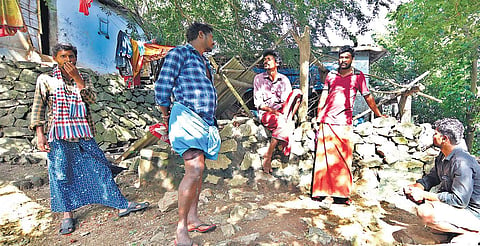

KOCHI: The wails of Sairandhri still echo in the mountain ridges of Silent Valley. The pristine rain forest, guarded by the breathtaking Nilgiris mountain ranges is known for its rich biodiversity. The valley is known as Sairandhrivanam for its unblemished pristine forests which have been largely undisturbed by human intervention. Sairandhri refers to Draupadi, wife of Pandavas in Mahabharata.
Attappadi, the tribal settlement located on the fringes of Silent Valley, has hogged the limelight often for the wrong reasons. Starvation, death of infants due to malnutrition and utter neglect of the government had made Attappadi the tears of Sairandhrivanam. Prime Minister Narendra Modi had once compared the sorry plight of the tribals in Attappadi with that of the kids in Somalia attracting the wrath of Keralites who boast about their development standards.
The silent sobs of the tribals in Attappadi speak volumes about the utter neglect of the government machinery. They roam the forest to collect honey and other forest produce, to eke out a living. The allegations of Maoist connection add to their woes.
A serpentine narrow road leads to Mele Manjikandi, a tribal settlement colony where around 50 tribal families live. A posse of police personnel holding guns was seen returning as our vehicle navigated through the winding road to reach the colony.
A 2-km trek from the colony, through the thick forest through marshy land and steep climbs, leads to the spot where Kerala’s elite commando force Thunderbolt gunned down four Maoists. Remains of a makeshift tent made of bamboo wood and creepers bear testimony of the gun battle on October 28. Bullet marks are visible in the trees and bamboo clumps around the spot. However, the tribals at Mele Manjikandi colony refuse to accept the encounter theory. “We were taken to the spot on Tuesday to prepare inquest report, when the shootout that led to the death of the fourth Maoist - Manivasakam - took place,” said Venkatachalam, a tribal and Padavayal branch secretary of CPI.
“We reached the spot around 9.45 am and we heard continuous gunshots from the upper terrain. The police asked us to lie down and I saw some policemen crawling ahead. We lied on the ground for around two hours till the fight was over. When we reached the spot, we saw deer meat kept in a bowl for cooking. A pot full of cooked rice, soup, bags of green gram, chilli powder, coriander powder, turmeric and some vegetables were kept in the tent. There were country guns, dresses, laptop and mobile phones lying scattered. The hands of one of the victims was completely mutilated while there was a deep bullet injury on the backside of the skull of the woman,” said Venkitachalam.
According to him, top police officers, RDO, sub-collector and some officers from Tamil Nadu were present at the spot when the 9 tribals were taken to the spot. “I didn’t notice any bullet marks on the trees during my visit to the spot on Tuesday. But when we visited the spot on Friday, there were bullet marks all around,” he said.
According to Koyen Moopan, the tribal head, who was the president of Puthur panchayat for 25 years, there was something fishy behind the incident. “We heard gunshots on Monday and thought that somebody was bursting crackers in view of Diwali. We came to know about the incident only on Tuesday. I don’t know whether the Maoists fired at the police party. If there was an encounter, the police personnel also would have suffered injuries. But not a single policeman has been injured. This gives room for suspicion,” he said.
However, the fresh incident of Maoist encounter is causing concern among the residents of various tribal settlements in Attappadi. More than the Maoists, the tribals fear the men in uniform. “The sight of gun-wielding cops send shudders down the spine. They stop and quiz people going to the village to buy essentials. Gun-toting cops check the vehicles and shout at us. We are afraid to go to the forest to collect forest produce as the police may shoot us alleging Maoist connection,” said a tribal youth, who refused to be named.
“The government should immediately withdraw the Thunderbolt commandos. It is evident that they have stage-managed the encounter. The victims may have followed Maoist ideology, but they never attempted any armed struggle. If they are allowed to continue here, they will kill the innocent tribals,” said Pudur panchayat president Jyothi Anilkumar.
The people living in nearby villages like Thavalam are also concerned about the presence of Thunderbolt cops. “People are afraid of them. Recently, they destroyed the three-acre millet farm of Nanjan, a tribal youth at Karuvara colony, as he was reluctant to obey them,” said P C Babu, a resident of Thavalam.
The Forest Department was also kept in the dark about the clandestine operation, which brings the entire operation under the shadow of a doubt. “Usually the police inform us before entering the forest for combing operation. But this time we were kept in the dark. We came to know about the operation only after the news was flashed,” said a forest officer.
Though Maoists had been operating in a clandestine manner in Kerala for the past two decades, they were not able to win the hearts of the people. The dense forests in the state offer a perfect hideout for the Maoists. They never targeted civilians and were more interested in using the seamless forests located in the trijunction of Kerala, Tamil Nadu, and Karnataka as a safe haven. They had put up posters calling for armed struggles but never tried for an open fight with cops.